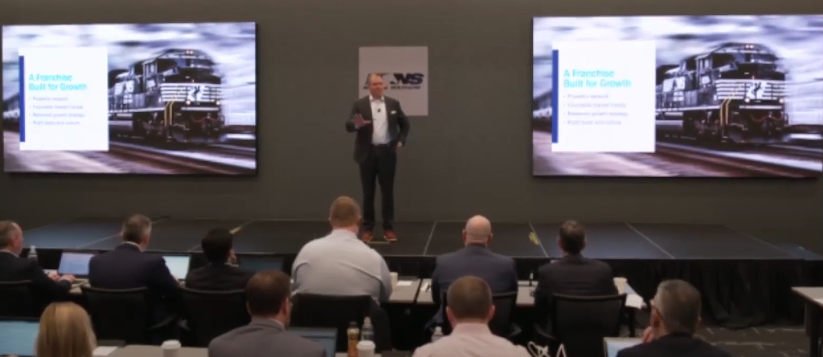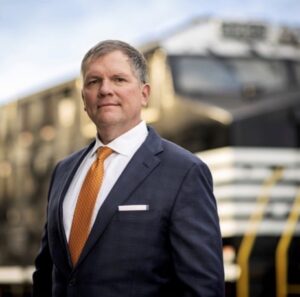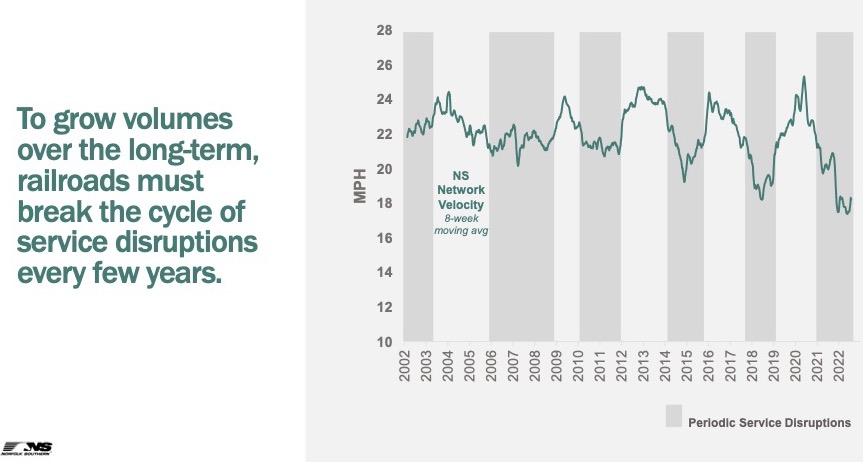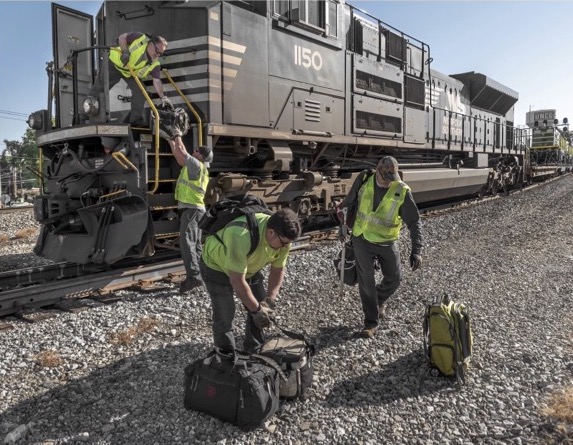
You have to give Norfolk Southern CEO Alan Shaw a standing ovation for his performance at the railroad’s investor day last month. Using logic as a sledgehammer, it took him just 10 minutes to demolish two of the things that have hurt rail service and put a lid on traffic growth: Excessive cost-cutting and an overemphasis on the operating ratio.

Shaw told a roomful of Wall Street analysts point blank that his railroad would no longer have a singular focus on its operating ratio. With the notable exception of Union Pacific, the Class I railroads have been heading in this direction. But Shaw publicly and forcefully explained why railroads need to turn the page in order to grow.
Instead of trying to cut its way to prosperity, NS aims to build a railroad with the resources required to provide reliable service year in and year out. The really big news here is that NS is attacking the root cause of the railroad industry’s recurring bouts with service problems: The practice of furloughing train crews at the drop of a hat, then acting surprised when they don’t return to the railroad.
“Our traditional approaches for dealing with business cycles — by furloughing temporarily surplus employees and tightening other spending when demand falls off — did not work well,” Shaw says. “When the time came to rebuild our ranks as freight transportation demand returned, we were unable to rehire quickly enough to operate fluidly. Today, we are still recovering from the disruption of the pandemic. Our service has turned the corner, but we are not yet at our desired level of staffing, or at the level of service that our customers expect.”
The Class I railroads get caught short of crews every three or four years. In the short term, this creates congestion, increases costs, and means railroads can’t handle all the freight that wants to move on rail.

“In the long term, these disruptions have eroded the confidence customers need to have if they are going to structurally rely on rail instead of highways,” Shaw says. “A company can’t expect to provide sustainable growth if it provides its customers with a lousy service product every three years.”
To break this cycle, NS will hang on to its engineers and conductors during downturns. The railroad will take advantage of having surplus crews to qualify them on new territories and to train conductors to become engineers. The idea is that NS will be able to attract and retain its skilled workforce, provide consistent service, and be able to handle a traffic rebound without skipping a beat.
This will inevitably raise the operating ratio in the short term. That’s been a no-no on Wall Street for investors who can’t see beyond the next quarter. Shaw says enough of this because in the long run, furloughs backfire.
Shaw outlined a hypothetical downturn in which NS would normally furlough 5% of its conductors and engineers. Having those 375 people off the payroll for a year saves $35 million.
But when it comes time to recall them, only 175 return. So NS has to hire and train 200 new conductors, which costs $10 million and takes months. Meanwhile, service suffers, and with operations in the ditch, costs go up $160 million for the year. Then figure that NS misses out on 5% of the potential traffic volume due to poor service. That’s at least $600 million in lost revenue.
In other words, furloughs intended to save the railroad $35 million actually end up costing it $770 million – and far more if you factor in shipper frustration.
Carrying full staff through a normal downturn will let NS carry more traffic, bring in more profitable revenue, and generate more growth. “Resilience is an investment in long-term shareholder value,” Shaw says.
Amen to that.

In a long recession, NS still would resort to furloughs, but would provide financial incentives for crews to return. On the flip side, NS also says it has better forecasting tools to match traffic demand with crew levels, which will enable it to handle traffic surges. This is still more art than science, and easy to get wrong. As Yogi Berra said, “it’s tough to make predictions, especially about the future.”
Give NS credit, though. It has officially stepped out of the shadow that the Cult of the Operating Ratio has cast on the industry for far too long. Yes, NS still has to walk the walk and execute on its plan to balance service, productivity, and growth. But it’s encouraging that Wall Street seems willing to play along for now.
Shaw has made it crystal clear that cost-cutting has reached the bumper post – and that the industry’s future is tied to better service.
You can reach Bill Stephens at bybillstephens@gmail.com and follow him on LinkedIn and Twitter @bybillstephens
Watch Norfolk Southern CEO Alan Shaw explain the railroad’s new strategy.














Lots of yapping and that is it. We’ll see how this pans out, but I have no real confidence in the future of the railroad. Morale is in the dumps, they can’t retain new employees and a vast majority of the furloughed are not coming back. They didn’t offer them any incentive, but promised new hires a bunch of cash. Not a great way to get experienced employees to come back. The retention of new hires is very low. Improve working conditions and quit denying every day off request. I just don’t see things improving just because Shaw says what some interpret as the ‘right thing’. Just words until proper action supports them. Oy!
Bean counters get in and that is all they know is cutting costs to raise the profit no matter what it takes. Management knows they get no bonus unless they grow profits so they go with the flow. They have long forgotten the mantra of “Best Business Practices”. You combine everything to grow the company and profits by having a good workforce , a front office that knows that it is not a good profit unless you got it by helping your customers grow and their profit flows to you. I note CP just announced a great last quarter. They did that by not growing business at all but instead made more money by fuel surcharges and increase the rates charged for shipping. It takes years to grow your customer base by gaining more customers and only minutes to completely lose customers for good.
And while you’re at it, take away the “cameras in your face” idea in the cab and give the crews the paid sick days they need and deserve. Make morale good again and you might just hang on to crews. Yes, easier said than done and no, I am not railroader, just a railfan, but I feel for the crews and their hard work. Thanks for keeping the rails shiny. And please be safe out there.
At last! A Man of Sense! It should be noted that HOW operating ratios have changed over the years, especially since 1978. There were also some real “freaks” in operating ratios. Car Hire fees, which used to be separately stated in the old pre-1978 ICC reports and the Moody’s Manuals (whoever has consulted current ones in recent years?). These came AFTER the calculation of operating ratio—BUT the expense of maintaining freight cars counted as an expense in operation ratios. Thus the P&LE with over 10,000 cars and 151 miles of line in a good year had operating ratios in the high 90’s and in a bad year they crept over 100. Yet the old P&LE until the steel industry collapsed was one of the industry’s most profitable railroads paying 15% dividends on par and operating the last unsubsidized commuter train in America. EHH’s OR was NOT your father’s OR!
The critical takeaway here is for Amtrak’s corporate management and decimated Board to take this lesson to heart and respond to a congressional oversight committee why Amtrak took all those funds; yet, still cashed out/laid-off significant numbers of T&E crews and maintenance forces; with a singular focus on bonusing themselves.
What continues to be the actual dollar cost losing experienced staff? Besides failing to operate its trains as scheduled, as well as to fulfill sleeper reservations due to car shortages, what is the price for continuing to recruit, orientate, and train? Is this the payback for tolerating political manipulation to install corporate management lacking the requisite railroad experience, let alone a Board devoid of the necessary experience for effective stewardship and accountability?
Good for the Norfolk Southern. Are you listening Union Pacific?
And now maybe take some pride too in your appearance and maintain/wash the dang engines. It is a reflection on leadership and pride. Just look at how our Navy ships look these days. 🙁
Suggest that inviting a few Craft leaders and some T&E folks to join Mr. Shaw in these types of forums would boost the perception of “outsiders” that the Brotherhoods are “on board” with this refreshing change of strategy.
Yes Mr. Holte, those calendars were “beautiful”. I bought two every year and sent one to a good friend. It was hugely disappointed to find out they had been discontinued. In a way I wasn’t surprised. Hunter Harrison was running rampage at CSX implementing PSR and NS decided it needed to jump on that bandwagon or CSX was going to run away with the business in the traffic lanes they competed in. Yes, Mr. Shaw no needs to show us he will “walk the walk” but I’ll be optimistic. Maybe he will even bring back the calendars.
2023 NS calendars are on sale on NS Company store website.
I guess Mr. Shaw’s career plans don’t indicate his desire to be on the payroll at UP. Like Mr. Giblin says we have to see if he can produce as talk is cheap.
It took real cojones to stand up to the analysts and tell them their blind-eyed devotion to OR was costing, not saving money. Hooray for Alan, and hope Fritz and the others get the message!
Analytics baby. NS has all the data they need, they just ignore it.
Think of the tension between Billy Beane and Art Howe in the movie “Moneyball”. Art was old school and ran his lineup card just like they did in 1896. American railroads still work like 1896.
Well, all it takes is a few recent college grads with degrees in analytics and some programmers with open source software and in 6 months you could have a brilliant operations platform.
It took Bezos a couple of years to get his sales prediction model in place using what is now AWS. I don’t see it being that much more difficult for a new school railroader. Traffic analytics and prediction software should be the normal.
As Mr. Giblin said, let’s see if he actually does what he says he’s going to do. I am a little concerned that he cited the pandemic and not PSR per se as the cause of the problem. I would like to see all the Class 1s declare that the PSR model failed and is from this day forward relegated to the ash heap of history (thanks, Ronald R.).
The sad thing is even though I don’t have a college degree, I do have 63 years of life and business experience. I could have told these bozos in 2017 that PSR was a horrible idea and would lead to all the problems the railroads have now. Anyone with an ounce of common sense could have seen this disaster coming long before it hit.
The leadership at UP must be graduates of the self-esteem movement that infected public education 20-30 years ago. The end results were that American high school students scored well on their self-evaluations but finished near the bottom of the industrialized world on standardized tests. Feeling good about yourself while being a complete ignoramus is no way to go through life. The folks at UP are about to learn some very hard lessons; I just hope the company can attract some intelligent leadership and right the ship before it capsizes and sinks.
Thanks, Bill, as always, for such an insightful look at Shaw’s Investor’s Day comments. But, now, as Mr. Salisbury notes above, NS has to walk the walk. Easy enough for the CEO to turn the wheel in the bridge house – now let’s see if the boat (NS) actually makes the turn.
Quite a contrast, to put it mildly, between Mr. Shaw’s statements and UP’s display before the STB last month. If utterances from the C-Suite are anything to go by, Mr. Shaw clearly “gets it,” while UP will continue to flounder for the foreseeable future.
The Lords of Omaha are well known for their hubris.
Hopefully NS can resist any pressure the third-rate stockbrokers (AKA Wall Street analysts) might apply to counter this.
I worked in the transportation industry for 30 plus years; (trucking) and endured endless wiz kids with some sort of business degree who told you that you (the front line employee) were the problem and would listen to no old fossils.
Endless articles in Trains over the years about PSR was a factor in me cancelling my Trainsmag subscription.
If there is finally a turn away from Wall Street activists only focusing on the next 90 days I may re-up my subscription to Trains . ( I have never left Classic Trains )
Now if someone can fix the leadership at Amtrak especially the long distant trains ; We read of all sort of airline problems but thanks to streaming railfan cams ; see the Capitol and Texas Eagle and the Southwest Chief with either no sightseer lounge or set at a fixed consist ( 6 cars for the Chief) no matter how early the short trains sell out.
If there was a fare structure similar to the airlines that offer real deals to fill the seats then Amtrak could certainly keep a 8 car Superliner train reasonably full.
As the NS president says you cannot cut your way to sucess.
True in many industries and business. The “wiz” kinds and MBA’s with no experience often have moved on with glowing resume’s of their accomplishments and savings, when the damage rears its head!
One other advantage to the NS strategy is a happier and more comfortable work force, less at loggerheads with management. I’d add a few millions on the plus side for that.
Mr. Shaw talks the talk. Now let’s see if he can walk the walk.
Now there’s a breath of fresh air, let’s hope the quarterly report crowd doesn’t loose it!
CONGRATULATIONS TO NS PRESIDENT SHAW, WHO IN A LONG TIME, IS THE FIRST EMPEROR WHO REALIZES HIS FELLOW CLASS 1 COLLEGES, ESPECIALLY IN THE RECENT PAST, HAVEN’T BEEN WEARING ANY CLOTHES! BTW, NS HAS RESUMED ITS ANNUAL CALENDARS, AVAILABLE ON NS “COMPANY STORE” WEBSITE. ANY RELATION BETWEEN THE TWO? WALTER FRITZ, OBER, INDIANA 574-772-4766
NS had a contest every year for employees who wanted to submit a photo for use in the calendar. An assistant track supervisor friend on my home territory had 2 photos published in 2 different calendars. Every employee was given a calendar at the start of the year, and they were beautiful.
Fake it till’ ya make it? Sad